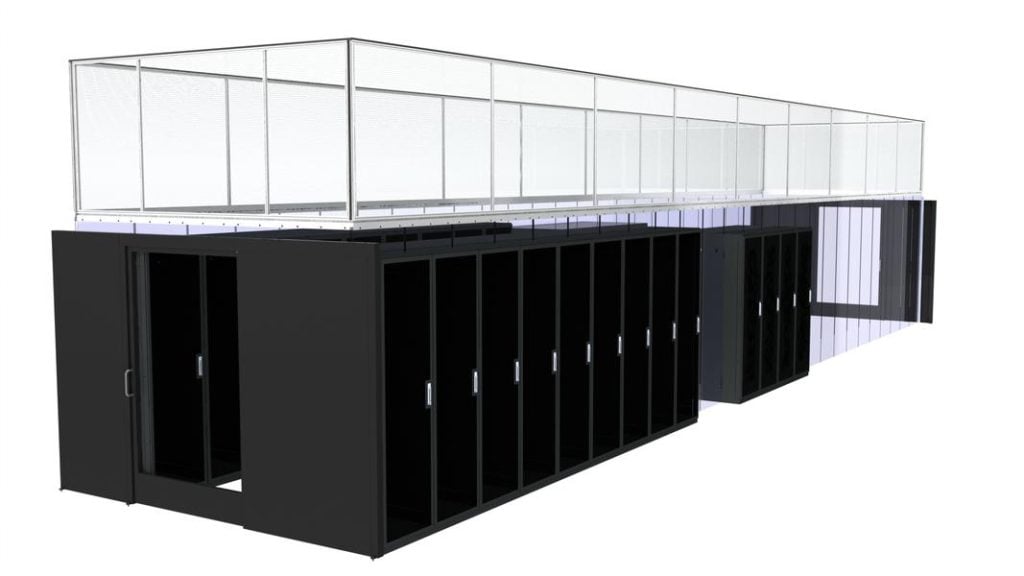As technology evolves at an unprecedented pace, data center trends for 2025 are poised to shape how businesses manage and store data, meeting the demands of a more connected and data-driven society.
Data centers are the foundation of our digital world, enabling everything from e-commerce and video streaming to cloud-based applications and critical business operations.
The coming year brings a pivotal moment for the industry, with advancements aimed at tackling challenges like rising energy demands, sustainability goals, and cybersecurity risks. As companies seek to improve operational efficiency, the future of data center technology in 2025 will revolve around innovations such as edge computing, AI integration, and hybrid cloud models.
One of the most transformative developments is edge computing in data centers by 2025, which enables faster data processing closer to the source, reducing latency for real-time applications like IoT and autonomous systems. Similarly, the rollout of 5G networks will demand robust data centers to handle the massive influx of data, revolutionizing the way we connect and interact globally.
Introduction
In this blog, we’ll explore these emerging trends and more, from sustainability initiatives aimed at reducing carbon footprints to AI-driven automation improving security and workload management. By understanding the data center trends for 2025, businesses and technology leaders can prepare to navigate a rapidly changing landscape and capitalize on the opportunities ahead.
Read on as we uncover the key innovations set to redefine the industry this year and for data center solutions, visit Reboot Monkey’s website or contact us to learn more.
Read on as we uncover the key innovations set to redefine the industry this year and for data center solutions, visit Reboot Monkey’s website or contact us to learn more.
Key Data Center Trends for 2025
The Rise of Edge Computing in Data Centers by 2025
Edge computing is reshaping the traditional data center model by bringing data processing closer to the source. Unlike centralized data centers that rely on transferring large amounts of information to and from distant locations, edge computing minimizes latency and supports real-time applications.
By 2025, edge computing in data centers will become a cornerstone for industries that depend on speed, efficiency, and localized data processing.
Benefits of Edge Computing
Edge computing offers several distinct advantages that set it apart from conventional models:
- Reduced Latency: Data is processed near the point of origin, significantly reducing delays. This is critical for applications like autonomous vehicles and smart city technologies, where real-time decision-making is essential.
- Bandwidth Efficiency: By processing and filtering data locally, edge computing minimizes the amount of information that needs to travel to centralized servers, saving bandwidth and reducing costs.
- Scalability: Edge nodes can be easily deployed in various locations, making it a flexible solution for businesses expanding into new regions or supporting diverse applications.
How AI at the Edge is Revolutionizing Real-Time Decision Making | Reboot Monkey
Real-World Applications
The rise of edge computing in data centers by 2025 is already evident in industries like retail, manufacturing, and healthcare. For instance, a major retailer implemented edge computing to optimize inventory management across multiple stores.
By processing data locally, the system provided real-time updates, reduced errors, and improved customer satisfaction. Similarly, in healthcare, edge computing enables faster analysis of patient data in remote clinics, improving diagnostic accuracy and treatment speed.
| Feature | Benefit |
| Reduced Latency | Faster response times |
| Bandwidth Efficiency | Lower costs and better resource usage |
| Scalability | Easy deployment across regions |
Preparing for 2025
As industries adopt technologies like IoT and autonomous systems, the demand for edge computing in data centers by 2025 will continue to grow. This shift allows businesses to meet the increasing need for localized data processing, delivering better performance and more reliable services in a rapidly changing digital landscape.
Sustainability Trends in Data Centers for 2025
As data centers become the backbone of the digital economy, sustainability has shifted from an option to a necessity. The sustainability trends in data centers for 2025 focus on addressing environmental concerns through energy efficiency, advanced cooling techniques, and renewable energy adoption. These measures not only reduce carbon footprints but also pave the way for long-term operational efficiency and regulatory compliance.
Innovations Driving Sustainability
Data centers are adopting cutting-edge practices to meet their sustainability goals:
- Liquid Cooling Systems: This method is far more efficient than traditional air cooling, enabling data centers to manage heat more effectively while reducing energy usage.
- Renewable Energy Integration: Solar and wind power are increasingly becoming the primary energy sources for data centers, helping operators reduce dependence on fossil fuels.
- Carbon-Neutral Goals: Tech giants like Google and Microsoft are leading the charge by committing to achieve zero carbon emissions within their data center operations.
Data Center Technicians On-Demand: The Key to Seamless Operations | Reboot Monkey
Comparative Analysis of Cooling Methods
| Traditional Cooling Systems | Liquid Cooling Systems |
| Higher energy consumption | Lower energy requirements |
| Limited scalability | Flexible and adaptable to workloads |
Practical Benefits of Sustainability
Implementing sustainability trends in data centers for 2025 yields multiple advantages:
- Cost Efficiency: Energy-efficient cooling and renewable energy integration lower operational costs over time.
- Regulatory Compliance: Governments are tightening environmental regulations. Adopting sustainable practices ensures compliance with these laws.
- Enhanced Reputation: Companies leading in sustainability attract environmentally conscious clients and partners.
Real-World Insights
Data centers in Singapore, a region where over 90% of energy comes from natural gas, are transitioning toward renewable solutions. Operators using liquid cooling and solar energy are not only reducing costs but also meeting global sustainability benchmarks.
As the industry progresses, adopting sustainability trends in data centers for 2025 will be crucial for businesses to remain competitive while addressing environmental challenges. These initiatives represent a necessary evolution toward a greener, more efficient future for the digital infrastructure.
Rack and Stack Services: Harnessing the Full Potential of Rack and Stack Services | Reboot Monkey
AI and Automation in Data Centers 2025
The rise of artificial intelligence and automation is fundamentally changing the way data centers operate. By 2025, AI and automation in data centers 2025 will be essential tools for improving efficiency, reducing downtime, and ensuring robust cybersecurity. As businesses rely more heavily on digital infrastructure, these technologies will play a pivotal role in driving operational success.
Key AI Applications in Data Centers
AI’s integration into data centers is not just about automation; it’s about smart, data-driven decisions that improve performance:
Predictive Maintenance:
AI tools analyze patterns and predict potential failures before they happen, reducing downtime and avoiding costly repairs. This ensures that critical systems remain operational at all times.
Dynamic Workload Allocation
Automation powered by AI optimizes resource usage by distributing workloads intelligently, reducing energy consumption and maximizing performance.
Enhanced Security
AI strengthens cybersecurity by detecting and responding to threats in real time, safeguarding sensitive data from increasingly sophisticated cyberattacks.
Real-World Impact: A Case Study
A global financial institution utilized AI-driven monitoring systems to identify inefficiencies and vulnerabilities within its data center. These tools reduced system downtime by 30%, saving the company millions of dollars in lost productivity and maintenance costs. This example highlights the tangible benefits of adopting AI and automation in data centers 2025.
| AI Application | Impact |
| Predictive Maintenance | Reduces downtime and repair costs |
| Dynamic Workload Allocation | Maximizes resource efficiency |
| Enhanced Security | Proactive threat detection and response |
Future Implications of AI and Automation
By 2025, the widespread adoption of AI and automation in data centers 2025 will enable operators to handle growing data volumes with greater precision and efficiency. Additionally, these technologies will provide businesses with real-time insights, enabling faster decision-making and more adaptive strategies.
The integration of AI not only improves day-to-day operations but also ensures that data centers remain competitive in a rapidly evolving digital environment. As cyber threats and operational demands increase, AI and automation will be indispensable in maintaining secure, efficient, and reliable data center operations.
Data Center Infrastructure Evolution by 2025
The growing complexity of modern workloads is driving significant changes in how data centers are designed and operated.
By 2025, data center infrastructure evolution by 2025 will center around modular and flexible solutions that can adapt to evolving demands. One key innovation leading this transformation is hyperconverged infrastructure (HCI), which integrates storage, computing, and networking into a unified system.
Advantages of Hyperconverged Infrastructure
HCI is quickly becoming a preferred choice for businesses looking to optimize data center operations due to its numerous benefits:
- Simplified Management: With HCI, multiple systems are managed through a single interface, reducing complexity and saving time for IT teams.
- Faster Deployment: The modular design of HCI enables quick implementation, making it ideal for projects with tight deadlines.
- Cost Efficiency: By consolidating resources, HCI lowers the total cost of ownership and reduces maintenance expenses.
Real-Life Application: A Tech Startup’s Journey
A growing technology startup embraced hyperconverged infrastructure to meet its operational needs. The company was able to scale its data center quickly and efficiently, accommodating rapid growth without requiring significant upfront investments.
This case underscores how data center infrastructure evolution by 2025 is helping businesses adapt to changing demands with minimal disruption.
| Feature | Benefit |
| Simplified Management | Easier to maintain and troubleshoot |
| Faster Deployment | Quick setup for new projects |
| Cost Efficiency | Reduces hardware and maintenance costs |
The Future of Data Center Design
The data center infrastructure evolution by 2025 will also incorporate other emerging technologies, such as software-defined data centers (SDDCs) and advanced cooling systems. These innovations aim to create adaptable environments that can support artificial intelligence, machine learning, and other resource-intensive workloads.
As businesses continue to demand greater flexibility and scalability, the evolution of data center infrastructure will ensure that organizations can meet the challenges of a data-driven future. With HCI leading the charge, the industry is set to redefine efficiency and performance in 2025 and beyond.
From Smart Hands to Remote Hands, we offer solutions that ensure efficiency and security. Get your solutions now. Contact Us
The 5G Impact on Data Centers in 2025
The advent of 5G networks is set to revolutionize the digital landscape, and its effects on data centers are already becoming apparent. By 2025, the 5G impact on data centers in 2025 will include significant changes in how data is processed, stored, and transmitted. As 5G promises higher speeds, lower latency, and greater connectivity, data centers must adapt to meet these new demands.
Key Influences of 5G on Data Centers
The deployment of 5G networks will bring several transformative impacts:
- Higher Data Throughput: The increased speed of 5G networks will result in massive amounts of data being generated and transmitted. Data centers will require robust storage and processing capabilities to handle these volumes efficiently.
- Decentralization: 5G’s ability to process data closer to the source pushes the adoption of edge data centers. These smaller, localized facilities reduce latency and improve the performance of real-time applications.
- Support for IoT: With billions of connected devices relying on 5G, data centers will play a critical role in managing and analyzing this information seamlessly.
Real-World Example: Logistics Industry Transformation
A logistics company leveraged the 5G impact on data centers in 2025 by implementing edge data centers connected through 5G networks. This setup allowed real-time tracking of shipments, optimized supply chain management, and reduced delivery errors. Such use cases highlight the practical benefits of integrating 5G with data center operations.
| 5G Influence | Requirement for Data Centers |
| Higher Data Throughput | Advanced storage and processing power |
| Decentralization | Increased reliance on edge data centers |
| Support for IoT | Seamless connectivity for billions of devices |
The Future of Data Centers in a 5G World
As 5G networks become more widespread, the 5G impact on data centers in 2025 will drive advancements in infrastructure, including increased adoption of edge computing and hybrid cloud solutions. These innovations will allow businesses to leverage the full potential of 5G, enabling faster decision-making and more efficient operations.
Data centers must evolve rapidly to accommodate the unprecedented demands of 5G, ensuring that they remain the backbone of a hyper-connected, real-time digital ecosystem.
Hybrid Cloud Adoption in Data Centers 2025
The growing demand for flexible and efficient data storage solutions has accelerated the shift toward hybrid cloud models. By 2025, hybrid cloud adoption in data centers 2025 will be a critical strategy for businesses looking to balance security, scalability, and cost efficiency. This approach combines on-premises infrastructure with public and private cloud services, offering the best of both worlds.
Benefits of Hybrid Cloud Models
Hybrid cloud adoption offers several distinct advantages that make it an attractive choice for modern data centers:
- Flexibility in Workload Management: Businesses can allocate workloads based on their specific requirements. Sensitive data can remain on-premises, while less-critical workloads can utilize public cloud resources, ensuring optimal performance.
- Enhanced Disaster Recovery: A hybrid cloud setup provides robust backup and recovery options. By storing data across multiple environments, businesses can minimize downtime and recover quickly from disruptions.
- Improved Cost Efficiency: Hybrid cloud solutions allow businesses to optimize spending by scaling public cloud usage during peak times and relying on on-premises infrastructure for consistent workloads.
Real-World Application: Healthcare Industry Use Case
A healthcare provider implemented hybrid cloud adoption in data centers 2025 by storing sensitive patient information on-premises to meet compliance standards while leveraging the public cloud for advanced data analytics. This model enabled the organization to maintain data security while scaling operations and improving efficiency.
| Cloud Type | Key Benefits |
| On-Premises Cloud | High security and control |
| Public Cloud | Scalability and lower upfront costs |
| Hybrid Cloud | Combines security and scalability |
Future Implications of Hybrid Cloud Adoption
As technology evolves, hybrid cloud adoption in data centers 2025 will pave the way for greater integration of artificial intelligence, machine learning, and real-time data processing. Businesses will be able to manage resources more effectively, leveraging the strengths of both cloud and on-premises systems to meet dynamic demands.
By 2025, hybrid cloud models will no longer be optional but a necessity for organizations aiming to stay competitive in a rapidly evolving digital landscape. This approach offers the flexibility and resilience required to navigate the complexities of modern data center operations.
Security Trends for Data Centers in 2025
The growing sophistication of cyber threats is pushing data centers to adopt more advanced and proactive defense measures.
By 2025, security trends for data centers in 2025 will focus on reducing vulnerabilities and ensuring robust protection of critical infrastructure. Technologies like Zero Trust architecture and AI-driven threat detection are expected to play pivotal roles in safeguarding sensitive data and maintaining uninterrupted operations.
Rack and Stack Services: Harnessing the Full Potential of Rack and Stack Services | Reboot Monkey
Key Security Trends Shaping the Future
Several emerging strategies are becoming central to the fight against cyber threats:
- Zero Trust Networks: This approach assumes that every access request is a potential threat until verified. By enforcing strict identity verification and access control policies, Zero Trust minimizes the risks of unauthorized access.
- AI in Cybersecurity: Artificial intelligence enables real-time monitoring and threat detection. It can identify anomalies, neutralize attacks like Distributed Denial of Service (DDoS), and adapt to evolving threats faster than traditional security systems.
- Data Encryption: Encrypting data during transmission and storage ensures that even if breaches occur, the information remains protected and unusable to unauthorized parties.
Real-World Example: E-Commerce Security Success
An e-commerce company adopted AI-driven security protocols to strengthen its data center defenses. When a DDoS attack targeted its servers, the AI system detected and mitigated the threat within minutes, preventing service disruptions and safeguarding customer data. This example highlights how security trends for data centers in 2025 are critical for mitigating modern threats.
| Security Feature | Benefit |
| Zero Trust Networks | Minimizes unauthorized access |
| AI in Cybersecurity | Fast and accurate threat detection |
| Data Encryption | Protects sensitive information |
Preparing for the Future
As technology continues to advance, cybercriminals are finding new ways to exploit vulnerabilities. Security trends for data centers in 2025 will drive the adoption of innovative technologies, such as biometric access controls, blockchain for data integrity, and advanced firewalls.
Businesses must remain vigilant and adopt a layered approach to cybersecurity, combining these trends with regular assessments and employee training.
By staying ahead of evolving threats, data centers can maintain their role as the backbone of the digital world while ensuring the safety and reliability of their operations.
Explore secure colocation and reliable server migration services designed for performance and growth. Reach out now!
FAQs
What is Edge Computing, and how does it benefit data centers in 2025?
Edge computing involves processing data near its source rather than relying on centralized data centers.
By 2025, this reduces latency and enhances real-time performance, especially for applications like IoT devices and autonomous systems. It also decreases bandwidth usage and enables localized data management, improving overall operational efficiency.
How is AI transforming data centers?
AI revolutionizes data centers by automating key operations like predictive maintenance, workload optimization, and security monitoring. It minimizes system downtime by identifying issues before they escalate, ensures efficient resource utilization, and enhances cybersecurity through real-time threat detection and response, making data centers smarter and more reliable.
What are the main sustainability trends in data centers for 2025?
Sustainability in data centers focuses on liquid cooling systems, renewable energy sources like solar and wind, and achieving carbon-neutral goals. These initiatives reduce energy consumption, lower operational costs, and align with environmental regulations. Ensuring data centers meet growing demands without compromising ecological balance.
How does 5G affect data centers?
The rollout of 5G drives increased data volumes, requiring decentralized edge data centers to handle high-speed, low-latency applications. It supports billions of connected IoT devices, enabling faster processing and seamless connectivity.
This shift demands robust infrastructure and scalable solutions to meet the unprecedented demands of 5G-enabled technologies.
Why is hybrid cloud adoption important?
Hybrid cloud adoption allows organizations to balance security and scalability by combining on-premises systems with public and private cloud solutions.
It improves disaster recovery, offers cost-efficient resource management, and provides flexibility to adapt to changing workloads. Making it an essential strategy for modern data center operations.
Conclusion
The future of data center technology in 2025 offers immense potential for businesses to innovate and adapt to evolving demands. Key data center trends for 2025 highlight the growing importance of AI integration, hybrid cloud adoption, and sustainability initiatives.
These advancements are essential for managing increasing workloads while improving efficiency and environmental impact.
Sustainability remains a pressing focus, with renewable energy and liquid cooling systems becoming standard practices. These changes address global environmental concerns and help data centers align with regulatory requirements while reducing operational costs.
Edge computing and 5G are transforming data center infrastructures, driving decentralization and enabling real-time data processing. By supporting IoT and other technologies, these trends offer faster, more scalable solutions for modern business needs.
Cybersecurity also remains at the forefront, with AI-driven tools and Zero Trust networks providing advanced protection against emerging threats. These measures are critical to safeguarding data in an increasingly connected world.
The future of data center technology in 2025 is about creating adaptable, secure, and efficient systems. Businesses that embrace these trends will position themselves to thrive in a fast-changing digital landscape. Ensuring long-term success in a data-driven economy.
About Reboot Monkey
Reboot Monkey is a trusted provider of data center solutions, helping businesses stay ahead of data center trends for 2025.
Contact us to discover how cutting-edge innovations like AI, hybrid cloud models, and sustainable practices can transform your IT infrastructure. Prepare for the future with Reboot Monkey’s expert guidance.







